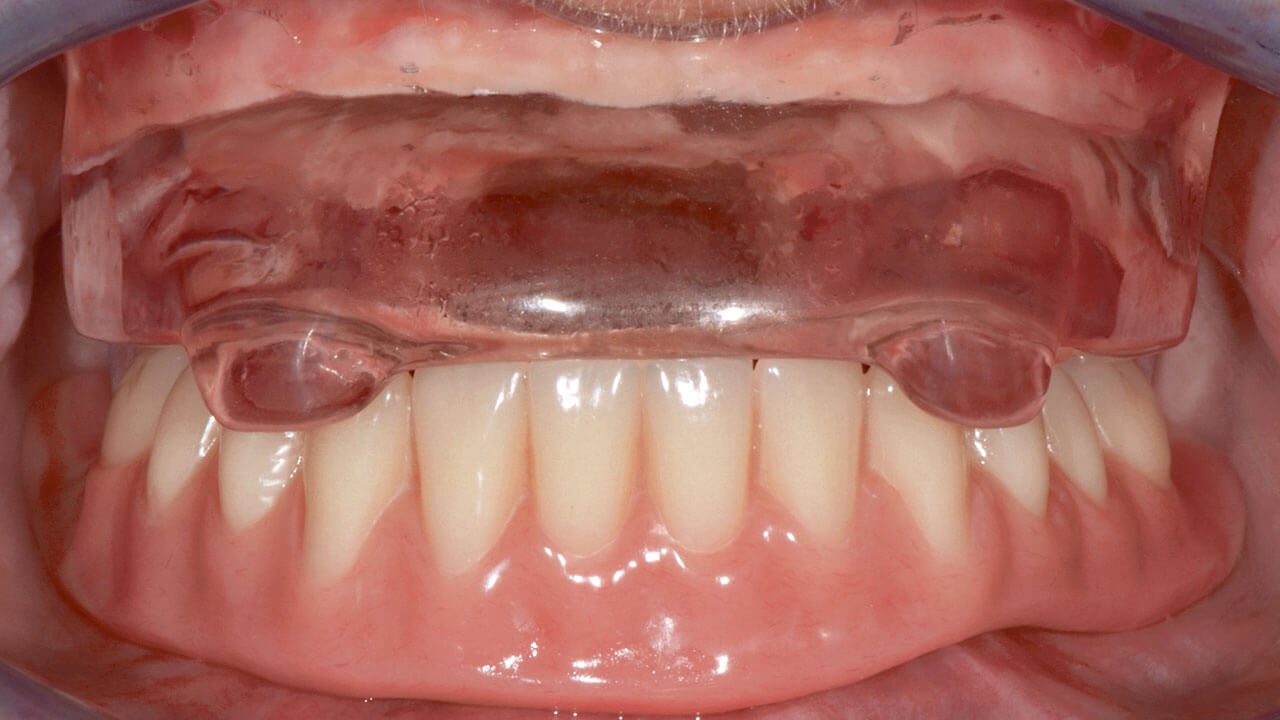Quintessenz Zahnmedizin, 2/2021
ProthetikPages 164-173, Language: GermanZitzmann, Nicola U. / Kraljevic, Iris / Glenz, Fabienn / Zimmermann, Salome D. / Joda, Tim / Dedem, PhilippDas Ziel dieser retrospektiven Kohortenstudie war es, das Langzeitergebnis individuell angefertigter Wurzelstiftkappen (WSK) von bis zu 20 Jahren zu untersuchen und mögliche Faktoren zu identifizieren, die das Komplikationsrisiko beeinflussen. Die Patientenauswahl erfolgte auf Grundlage der Behandlung mit an WSK retinierten Deckprothesen (DP, „Overdenture“) in einem universitären Umfeld. Die Datenerhebung umfasste dentale und parodontale Parameter, Einzelzahn-Röntgenaufnahmen und die Bewertung des DP-Designs. Die Patientenzufriedenheit wurde auf einer visuellen Analogskala (VAS) erfasst. Die kumulativen Überlebens- und Erfolgsraten wurden über 20 Jahre berechnet. Es wurden
73 Patienten mit 81 DP und 152 WSK eingeschlossen. Die WSK-Überlebensrate betrug 80,9 %, die WSK-
Erfolgsrate 64,5 % nach einer mittleren Beobachtungszeit von 105,4 (± 67,9, von 6 bis 240) Monaten. Die kumulativen WSK-Überlebensraten nach 5 Jahren betrugen 91,5 % und die WSK-Erfolgsraten 79,3 %.
Die Aktivierung von Kugelmatrizen erfolgte häufiger im Vergleich zu zylindrischen Retentionselementen (OR 0,43; CI95 0,2; 0,94, p = 0,034). Die Prothesenretention wurde bei zylindrischen Retentionselementen mit 96 % (IQR 89,5; 100) signifikant besser bewertet als die Retention bei Kugelattachments mit 88 % (IQR 79; 98,2; p = 0,012). Das Risiko für WSK-Komplikationen war beim parodontal geschlossenen DP-Design höher als beim parodontal offenen Design (OR 0,34; CI95 0,15; 0,78; p = 0,010). Zur Retention von DP bei teilbezahnten Patienten sind individuell angefertigte WSK auf natürlichen Pfeilerzähnen eine valide Therapieoption. Ein korrektes Prothesendesign und die Integration der Patienten in ein regelmäßiges Dentalhygieneprogramm sind entscheidende Faktoren für den langfristigen Erfolg.
Keywords: Abnehmbarer Zahnersatz, Overdenture-Prothesen, Wurzelstiftkappen, Überleben, Erfolg
Journal of Craniomandibular Function, 4/2020
Pages 345-355, Language: English, GermanDedem, Philipp / Türp, Jens ChristophIntroduction: The fabrication of a stabilization (Michigan) appliance for edentulous patients suffering from temporomandibular disorders remains a challenge. This article describes a complete denture Michigan splint, where a maxillary removable denture and stabilization appliance was fabricated as one single piece.
Case presentation: A 76-year-old edentulous female presented for replacement of her insufficient 20-year-old removable complete dentures. The patient was also diagnosed with arthralgia of the right temporomandibular joint and myofascial pain in the right masseter muscle. First, a new set of dentures was made with an increased occlusal vertical dimension of 2 mm to compensate for the current reduced vertical height. In an attempt to manage the temporomandibular pain, a single-piece maxillary complete denture splint was manufactured through CAM milling of a polymethyl methacrylate block. The denture splint was worn at night during sleep instead of the maxillary complete denture. It was tolerated well, and the temporomandibular pain had vanished 3 months later.
Discussion: The complete denture Michigan appliance showed a perfect fit on the oral mucosa. Further advantages of this design were the avoidance of possible retention loss between a conventional splint and a complete denture, increased patient comfort, increased durability of the appliance, and reduced risk for systemic effects due to a lower residual monomer content. The presence of a digital data set allows for the making of a duplicate in an effective way if the denture splint is lost.
Conclusion: Edentulous patients suffering from temporomandibular pain may benefit from a maxillary complete denture Michigan splint as an alternative to a stabilization splint placed on a complete denture.
Keywords: complete denture, computer-aided design, temporomandibular disorders, edentulous jaw, occlusal splints
International Journal of Computerized Dentistry, 1/2016
PubMed ID (PMID): 27027103Pages 63-76, Language: English, GermanDedem, Philipp / Türp, Jens C.Aim: To investigate whether the fully digital, plasterless fabrication of clinically usable Michigan splints can be accomplished in a time- and cost-efficient manner.
Materials and methods: Digital scans of the maxillary and mandibular arches of 10 subjects were acquired with an intraoral scanner (3Shape, Copenhagen) and used to generate virtual models of the dental arches. Jaw relation records were made using jigs placed on the subjects' anterior teeth, and silicone registration material was referenced to the jaw models. The data sets were then sent via the company's online portal to the dental laboratory, where computer-aided design (CAD) of the Michigan-type maxillary splints was performed. After receiving the designs, the splints were milled in-office using computer-aided manufacturing (CAM) software, and finished manually. During try-in, the splints where checked for fit, retention quality, and occlusal contacts of the mandibular teeth on the splint surfaces in static and dynamic occlusion.
Results: Fit and retention were clinically acceptable in 10 splints and 9 splints, respectively. The number of initial occlusal contacts on the splint surfaces ranged from 4 to 16.
Conclusions: The question addressed in this study can be answered in the affirmative. Some of the main advantages of digital manufacturing of Michigan splints over traditional, conventional, impression-based manufacturing are the time-efficient manufacturing process, the high material quality, and the possibility of manufacturing duplicate splints.
Keywords: workflow, digital impression, intraoral scanning, computer-aided design, computer-aided manufacturing, jaw relation record, occlusal splints, craniomandibular disorders, bruxism




